| Lot |
Photo |
Description |
Realized |
Lot 675 |
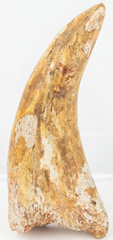 |
Museum Quality 4 ½ Inch Carcharodontosaurus Hand Claw. This museum quality 4½ inch Carcharodontosaurus Hand Claw is from a Theropod Dinosaur that had the Jurassic Theropod Allosaurus as an ancestor although it was much larger, approaching or exceeding the size of a T-Rex. This large beige and light brown hand claw is complete with a sharp point and excellent bone detail and no restoration. In life this hand claw would be covered in keratin, the same substance as our finger nails are made from, and would be at least 25 per cent larger. 80 million years old from the Kem-Kem basin of Morocco. Estimate Value $3,000 - UP
View details and enlarged photo
| Realized
$2,400 |
Lot 676 |
 |
Three Museum Quality 260 Million Year Old Primitive Amphibians. Discosauriscus pulcmerismus was an early 260 million year old amphibian unrelated to modern amphibians that somewhat resembled a salamander with a huge head and scaly and rough skin. Discosauriscus was an active predator in lakes and shallow pools. The two specimens on this 13 x 11 inch plate feature one 8 inch long specimen from the ventral position showing rows of small sharp teeth and one 7 inch specimen with a dorsal view showing the solid bony skull. Also, on the same slab is a ventral view 6 inch long Microperpetron amphibian also showing some teeth. It is rare to find even one amphibian specimen but finding three on one plate is exceptionally rare. These museum quality specimens were found in a quarry near Letovice in the Czech Republic. Estimate Value $2,200 - UP
View details and enlarged photo
| Unsold |
Lot 677 |
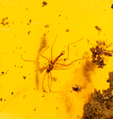 |
Mosquito (Aedes Culcides) in 100 Million Year Old Burmite Amber. Burmite amber from Myanmar (formerly Burma) is 98-105 million years old from the middle Cretaceous when dinosaurs roamed the earth. This small complete Mosquito (Aedes Culcides) in a clear golden colored 25 x 20 x 6 mm Burmite Nugget is very important as Jurassic Park suggested could contain some actual dinosaur blood. Of course, unlike the movie, even if there are some traces of dinosaur blood you could not clone a complete dinosaur from it. Aedes mosquitos still exist and one species of Aedes causes Yellow Fever in humans. There is also a clear Lepidoptera larva and several other flying insects preserved in this remarkable and important amber nugget. Housed in a 8 X 6 inch Riker Mount with a enlarged photo of the Aedes mosquito. Estimate Value $1,500 - UP
View details and enlarged photo
| Unsold |
Lot 678 |
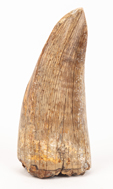 |
T-Rex Pre-Maxilary 1.9 Inch Tooth. Virtually all T-Rex teeth found are shed teeth that broke off when the T-Rex was feeding on some other dinosaur. Usually these teeth are just fragments or are broken into many pieces, but this large 1.9 inch Pre-Maxilary tooth is the exception. There is no restoration to this magnificent tooth, with most of the enamel surface intact and very good serrations. There is some natural feeding wear on the enamel at the tip that occurred when the T-Rex was still alive. This is a large Pre-Maxilary tooth from an adult T-Rex as the Pre-Maxilary teeth are smaller than the teeth further back in the jaw and were used to strip meat from the bone. They are very distinctive in having two rows of serrations close together on the inner curve of the tooth versus having one row of serrations on the opposite sides of the regular teeth. This 65 million year old treasure was found on a private ranch in the Hell Creek Formation of Montana and is displayed in a 5.5 x 4.5 inch Riker Mount. Estimate Value $1,500 - UP
View details and enlarged photo
| Realized
$938 |
Lot 679 |
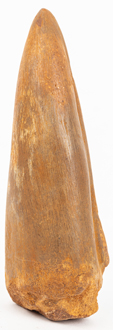 |
Huge Four Inch Long Carcharodontosaurus Foot Claw. Carcharodontosaurus was a huge theropod, perhaps even larger than a T-Rex. It was not closely related to a T-Rex but rather a close relative to the Jurassic Theropod Allosaurus. This huge four inch long Foot Claw is a light brown color with an excellent not-distorted shape. This extremely large impressive foot claw is 80 million years old from the Tegana Formation of the Kem-Kem basin of Morocco, North Africa. Estimate Value $1,200 - UP
View details and enlarged photo
| Realized
$1,050 |
Lot 680 |
 |
Camel Fossil Skull. Many strange and unusual mammals were found in western Nebraska and South Dakota 30-40 million years ago. Their rare and valuable fossils are sometimes found in the White River Badlands where they are uncovered by rain, wind and frost and are quickly destroyed unless they are found and collected. Poebrotherium was one of the very first camels over 30 million years old which originated in North America and not in Asia. It was the size of a sheep and lived in herds, standing only about 30 inches tall. It had longer hind legs than forelegs and was built for speed. This virtually complete skull is 8x2.5x3.5 inches and is still positioned on the stone matrix as found in Sioux County Nebraska. The quality is outstanding with just the very front teeth restored. A rare and important fossil that is seldom found so complete. Estimate Value $1,200 - UP
View details and enlarged photo
| Unsold |
Lot 681 |
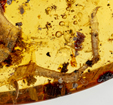 |
Partial Lizard Skin, Hand and One Complete Leg and Foot in 100 Million Year Old Amber. One of the rarest and most desirable of creatures in amber is that of a lizard. This remarkable 18mm long partial lizard is encased in a 33x14x8mm clear orange colored 100 million year old Burmite amber nugget that clearly shows a section of the skin of the lizard, missing the head but clearly showing one leg and foot with five sharp claws. Bacterial activity eats away at the lizard body leaving only the skin remaining. Housed in a 8x6 inch Riker Mount with a closeup picture of the lizard leg. Estimate Value $1,200 - UP
View details and enlarged photo
| Unsold |
Lot 682 |
 |
Several Thin Possible Dinosaur Feathers in 100 Million Year Old Amber. Most amber is too young to have dinosaur feathers in, but Burmite is the name for 100 million year old amber found in the Hukawang Valley in northern Burma (Myanmar). These feathers could belong to an early bird or theropod dinosaur because what defines a dinosaur and an early bird is somewhat blurred. Both Coelurosaurs and Tyrannosaurs are known to have been feathered from remarkable fossils found in China. These 8mm long thin feathers are exceptionally clear and beautifully preserved in a 17 x 10 x 3 mm polished cabochon of honey colored amber. The thin feathers have excellent detail and are symmetric which means that they are not flight feathers but rather most likely head or neck feathers, which also add to the probability that they are indeed dinosaur feathers.
Presented in a 8x6 inch Riker mount with an enlarged photo of the feathers. Estimate Value $1,000 - UP
View details and enlarged photo
| Realized
$600 |
Lot 683 |
 |
Partial Thescelosaurus Dinosaur Foot. This partial foot belongs to an 8 to 13 foot long herbivorous dinosaur that weighed between 450-650 pounds named Thescelosaurus. Thescelosaurus was one of the very last dinosaurs alive at the end of the Cretaceous. It was bipedal with a four toed foot. What makes this lot interesting is that all of the bones were found in the same dig in the 67 million year old Hell Creek Formation of Montana and belong to the same dinosaur, not a composite. The partial foot consists of parts of all four claws and six of the toe phalanges. All four claws would be about one inch long with two of the claws virtually complete except for the ends of the tips and the other two being partials. One toe is four inches long and complete with the best claw and three complete phalanges. The other three phalanges are partial. Thescelosaurus was a hypsilophodont dinosaur that is famous for the excellently preserved specimen found in 1993 in South Dakota that had a well preserved heart. Preserved in a 8x6.5 inch Riker Mount. Estimate Value $800 - UP
View details and enlarged photo
| Unsold |
Lot 684 |
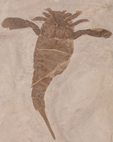 |
Museum Quality Complete Sea Scorpion Eurypterid remipes. Eurypterids, also known as sea scorpions, were fierce predators in the warm seas 425 million years ago. Some grew to over 6 feet long and easily hunted the slow moving armored fish of that era. They were related to scorpions and were probably the first animal to leave the sea and crawl out on dry land. This complete, highly detailed 4.25 inch sea scorpion comes from the famous 425 million year old Fiddler's Green Quarry of Herkimer County, New York. It is exceptionally rare in that it is complete with all six of the walking legs as well as the two paddles, being preserved with excellent detail along with an excellent head, body and telson (looks like the stinger in a scorpion but was not poisonous). The walking legs have amazing detail with the first two pairs of legs having feather-like ends that were used to sense prey. This Eurypterid is preserved in its underside (ventral position) which enables some detail of its mouth as well. This is the very best quality for a sea scorpion, with fewer than one in a hundred being even close to the quality of this specimen, which is nicely centered on a 6.5 x 4.25 hard gray matrix. Estimate Value $800 - UP
View details and enlarged photo
| Unsold |
Lot 685 |
 |
Lizard Tail With Blood Droplets In Madagascar Copal. Although insects are common in amber or copal, larger creatures such as lizards are rarely encountered because they are much bigger and can just walk away out of the gooey tree resin. Copal is just young amber that has not had the time to harden. This rare and spectacular .75 inch fossilized Lizard tail with four fossilized blood droplets is contained within a 1.75 inch clear fully polished cabochon of two million year old Madagascar copal. This fossil tells a story of a small lizard being trapped in tree resin and then shedding his tail to free himself and in this act leaving four blood droplets which still remain fossilized in this extraordinary specimen, beautifully preserved with excellent scales and brown color markings with bright red blood droplets. Both lizard and blood are extremely rare in copal or amber and complete small lizards have sold for more than $50,000 in amber. Presented in a 8 x 6 inch Riker mount. Estimate Value $800 - UP
View details and enlarged photo
| Unsold |
Lot 686 |
 |
Carcharodon Tooth With Scrimshaw Megalodon Diorama. Carcharodon megalodon was the largest shark that ever lived, growing to more than 50 feet in length. It ate whales whose bones are found right alongside with the huge teeth of megalodon. This 4.3 inch on the diagonal and 3.5 inches wide 15-20 million year old Carcharodon tooth was found in a deep water location (over 1000 feet) that was a three-day boat ride north of a small island called New Caledonia, about 800 miles east of Australia. Most of the teeth dredged from this depth are broken, but this is a complete tooth with a light brown root and enamel that is white in the center surrounded by light beige enamel--perfect for carving scrimshaw, a 16th century art form that originated with sailors who etched drawings onto whale teeth and filled in the scratches with ink. The intricate diorama carved and inked into the outer enamel of the megalodon tooth has two humpback whales swimming with a large Carcharodon megalodon lurking beneath them. The seafloor is represented by several types of corals and sponges. Signed and dated by the artist, "Kelly Kennedy 2005" at the bottom of the seafloor. Kennedy was renowned as a scrimshaw artist and died in 2008. Presented on a 3 inch illusion stand for display. Estimate Value $800 - UP
View details and enlarged photo
| Realized
$2,313 |
Lot 687 |
 |
Colorful Agatized Dinosaur Bone. Agatized dinosaur bone occurs when the hollow bone structure of the dinosaur is replaced by quartz and trace minerals such as iron over millions of years. The best quality agatized dinosaur bone comes from the Jurassic era in Utah from the 150 million year old Morrison Formation. The vast majority of the dinosaur bone found is just broken fragments, rarely is an identifiable bone found such as this 5 x 4 x 6 inch sauropod tail vertebrae. The tail vertebrae is pretty much complete except for the neural spine process. Only the top of this rare dinosaur bone has been polished to reveal the bone structure. The individual cells in the center of the bone are distinct and range in color from white calcite to many shades of brown all the way up to orange. This impressive fossil stands on its own on the backside of the vertebrae. Estimate Value $700 - UP
View details and enlarged photo
| Unsold |
Lot 688 |
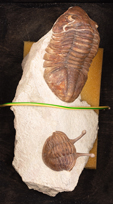 |
Pair Of Beautifully Preserved Russian Trilobites. The complete enrolled 2 inch Neoasaphus kowalewski was a very strange looking trilobite with extremely long one inch eyestalks from the Wolchow River near St. Petersburg, Russia. The second trilobite is a dark brown 3.5 inch long Neoasaphus trilobite with the more normal sized compound eyes. Trilobites from St. Petersburg, Russia are famous for being found complete with outstanding detail. Both of these trilobites are original with no restoration on their original matrix. Estimate Value $600 - UP
View details and enlarged photo
| Realized
$313 |
Lot 689 |
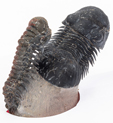 |
Pair of Museum Quality Moroccan Trilobites Fully Prepped. The two 375 million year old trilobites from Atchana in the Anti-Atlas Mountains of Morocco have been professionally prepared out of their original stone matrix, resulting in a stunning visual display in which the two different species of trilobites appear to be leaping from the matrix. The two black trilobites are a 2 ½ inch long Paralejurus hamiagdadicus and a 2 ¼ inch long Crotalocephalus gibbus leaping from a sculpted 2 ½ x 1 inch gray stone matrix. Both trilobites are complete with excellent body details, including the spikes extending around their bodies and excellent heads with even their hypostomes (mouths) exposed on the ventral side of their heads. Many hours of work were required to create such a realistic presentation of what trilobites looked like in real life. Estimate Value $500 - UP
View details and enlarged photo
| Realized
$312 |
Lot 690 |
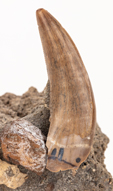 |
Juvenile 1 3/8 Inch T-Rex Tooth in Matrix. This complete T-Rex tooth is 1 3/8 inches long, thick for its size, complete with good serrations on the top and bottom of the tooth with a small crack on the bottom of the tooth. All T-Rex teeth are shed teeth except the very few that are found with the dozen or so partial skeletons that have been found. This dark brown tooth has no restoration and is still in a small 1½ x 1½ inch portion of its original matrix with some dinosaur bone fragments. It was found in an ancient river or lake bed on a private ranch in the 65-67 million year old Hell Creek Formation of Powder River County, Montana. Estimate Value $500 - UP
View details and enlarged photo
| Realized
$1,063 |
Lot 691 |
 |
Pair Of Fossil Crabs. Archaeoperyon puruvianus was a 25 million year old fossil crab from Argentina. What makes this fossil special is that there are two large crabs the largest being 8 inches and the smaller one 6.5 inches long, side by side as found in their original 14.5 x 5 inch stone matrix. Both crabs have complete carapaces and large claws with shearing teeth-like projections lining the claws with only the ends of some of the legs missing. There was a crack in the matrix that has been repaired but it does not affect the fossils. Finding one complete crab is rare but it is very unusual to find two crabs together in the same matrix and this makes for an impressive display. Comes with a plastic stand for display. Estimate Value $500 - UP
View details and enlarged photo
| Unsold |
Lot 692 |
 |
Colorful Ammonite -- 5½ Inch Cut Pair. Ammonites were early mollusks that somewhat resembled an octopus or squid living within a protective shell and are the closest relative to the chambered nautilus which still exists today. This specimen contains both halves of a large 5 1/2 inch in diameter 110 million year old ammonite, Cleoniceras from the large island of Madagascar. This ammonite has been cut in half and polished to reveal the detail and beauty of the inner chambers. The beautiful large ammonite has most of its inner chambers either filled with quartz crystals or filled with various colors of tans, browns and purple minerals from the solidified sand and mud of the sea bottom. Also, the septa between the chambers is lined with gold colored minerals. The outer side of the ammonite still retains some o the original mother of pearl with flashes of colorful iridescence. Two plastic stands are included for display. Estimate Value $500 - UP
View details and enlarged photo
| Unsold |
Lot 693 |
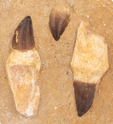 |
Three Large Mosasaur Teeth in Matrix. Mosasaurs were the T-Rex of the late Cretaceous oceans, being the top predator. They were huge marine reptiles 40-60 feet long, related to lizards and snakes. This 7¾ x 7 inch sandstone matrix contains three large Mosasaur teeth. The largest two teeth are 4¼ inches long including their original root with the third tooth at 1¼ inch long with no root. All the teeth have lovely brown enamel teeth contrasting with the tan colored original roots. These Mosasaur teeth are 70 million years old from Khourigba, Morroco. Estimate Value $500 - UP
View details and enlarged photo
| Unsold |
Lot 694 |
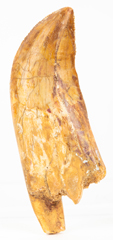 |
Carcharodontosaurus Dinosaur Tooth With Partial Root. Large 2.3 inch with a partial root dinosaur tooth of Carcharodontosaurus saharicus, the T-Rex of Africa. Carcharodontosaurus was as large or even larger than a T-Rex. This light brown tooth has very good enamel and good steak-knife-like serrations on both edges of the tooth. All dinosaur teeth with their original roots are rare as this means that the dinosaur tooth came from a skeleton of an actual dinosaur and not a shed tooth. More than 99% of all found theropod dinosaur teeth are shed teeth. This impressive tooth with no restoration was found in the Sahara desert of Morocco and Carcharodontosaurus was older than a T-Rex at 70-80 million years old. Carcharodontosaurus teeth are much thinner than T-Rex teeth and were excellent for cutting through flesh whereas the much thicker T-Rex teeth could easily bite through bone. Estimate Value $500 - UP
View details and enlarged photo
| Unsold |
Lot 695 |
 |
Spinosaurus Foot Claw And Tooth. The enormous theropod dinosaur Spinosaurus with a huge sail on its back remains an enigmatic dinosaur as no even remotely complete skeleton has been found and the only partial skeleton was destroyed in World War II. Spinosaurus is mostly known from its teeth which are fairly common but usually broken and ugly. This lot contains a complete 2½ inch foot claw that was found in two pieces and professionally reattached. Also included is a complete 2¾ inch long tooth with excellent brown enamel, a partial ¾ inch root with just some of the usual crack filling This 80 million year old dinosaur claw and tooth were found in the Kem Kem Valley near Taouz, Morocco. Estimate Value $500 - UP
View details and enlarged photo
| Realized
$313 |
Lot 696 |
 |
Otodus Obliquus Shark's Tooth in Matrix and Complete Priscacara Green River Fish. Two fine fossils in this lot. 1.) An authentic fossil shark tooth from the Eocene (54 Million Years) aged phosphate deposits near Khourigba, Morocco; Otodus obliquus, a type of giant mackerel shark. Tooth is 3 x 2" in matrix 5 x 4 x 1" with enamel intact. 2.) A nicely detailed 5" long Cockerellites (Priscacara) liops from the Eocene aged, Green River formation of Wyoming. Priscacara is 4¾ x 3 x ¼" and is complete. These make for a fine pair for any level of collector with both in excellent condition and striking visual appeal. Estimate Value $500 - UP
View details and enlarged photo
| Unsold |
Lot 697 |
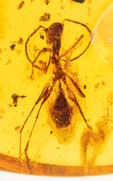 |
Strange Long-Legged Extinct Ant in Burmite Amber. This beautiful exceptionally clear 21x16 mm honey colored Burmite Amber cabochon features an 5mm long extinct species of ant that is very unusual looking with very long legs and very long antennae. There are also a couple of small insects. This unusual looking ant is most likely an extinct species from 100 million years ago that has not been named yet. Presented in a 8x6 inch Riker mount with an enlarged photo of the ant. Estimate Value $400 - UP
View details and enlarged photo
| Unsold |
Lot 698 |
 |
Priscacara Fish, Museum Quality. Priscacara was an extinct genus of Perch noted for its sharp and stout dorsal and ventral spines. This complete 52 million year old Priscacara is 4.75 inches long from the Promise Land Quarry of Lincoln County, Wyoming. The fish is complete with all its fins and is a dark brown color which nicely contrasts with the cream colored original limestone matrix. The 12 x 10 inch limestone matrix has been backed with wood and is ready to be hung if desired with a hanger and wire attached on the back. Estimate Value $400 - UP
View details and enlarged photo
| Realized
$300 |
Lot 699 |
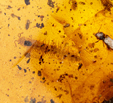 |
Millipede Plus Other Strange Insects in Burmite Amber. The 100 million year old amber from Myanmar (Burma), known as Burmite amber, is the most valuable amber because of its age and clarity. This valuable amber is a picture of insect life in the time of the dinosaurs. This large, mostly clear, honey-colored amber is 46x28x12 mm and features a complete millipede that is 6 mm in length, as well as other strange looking insects. A lot of the insects look a little different from the insects today because even insects have been evolving over the last 100 million years. Presented in 8x6 inch Riker mount with an enlarged photo of the millipede. Estimate Value $350 - UP
View details and enlarged photo
| Unsold |
Lot 700 |
 |
Trilobite -- 2 Inch Harpes Starship Shaped Bug. Harpes is one of the most interesting shaped trilobites that is found in the 385 million year old fossil beds of Erfoud, Morocco. Most trilobites have a very similar shape that takes an expert to tell them apart. Harpes is very distinctive with its wide cephalon along with long spines sweeping back to its tail, this trilobite looks something like a starship. This 2 inch excellent trilobite is complete with even a myriad of small bumps covering all of its surface which are called postules. The black trilobite is nicely centered on a thick 4½ x 2 x 2 inch limestone matrix. Estimate Value $350 - UP
View details and enlarged photo
| Unsold |
Lot 701 |
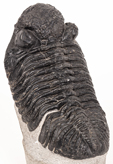 |
Trilobite -- Large 5.5 Inch Drotops. Most examples of the trilobite Drotops are only 2-3 inches long, but in the warm 375 million year old seas near Erfoud, Morocco, this trilobite grew to over 6 inches in length. This large 5.5 x 3 inch black trilobite has been esthetically cut out of its grey stone matrix to stand up in a life-like position on its natural 2.5 x 2 inch stone base. Complete with excellent detail on the head with its bumps (postules), most of the hexagonal lenses in one eye, and even the 1.25 inch mouth (hypostome) underneath the head. Trilobites were very successful surviving for more than 250 million years and were one of the very first animals to have sharp focusing eyes. Their compound eyes are very similar to those of many insects. Estimate Value $350 - UP
View details and enlarged photo
| Unsold |
Lot 702 |
 |
Primitive Whale Basilosaurus Partial Jaw and Tooth. Whales evolved from a four legged land predator (mesonychids) and the early whales still show characteristics of these bizarre wolf-like animals. Basilosaurus at 60 feet long was the largest predator in the ocean 40-45 million years ago. Basilosaurus still had vestigial hind limbs and land predator type teeth. The completely natural 4 ½ inch partial jaw contains a large dark brown 2 x 1 ½ inch cusped molar tooth with excellent enamel and one other partial tooth. This odd distinctive molar is double rooted with a high crown that was definitely used to tear flesh apart. This remarkable fossil was found in Wadi El Hitan Egypt which is known as Whale Valley. Basilosaurus is the state vertebrate fossil of Alabama and Mississippi. Estimate Value $300 - UP
View details and enlarged photo
| Unsold |
Lot 703 |
 |
Complete Unusual Crotalocephalus Trilobite. There are many different types of trilobites found at the 375 million year old rock of Hamar Laghdad, Morocco. Crotalocephalus has a unique look being longer and thinner than most trilobites. It looks something like an alien armored worm. This 2½ x 1 inch black trilobite is complete and has been expertly prepared in a natural 3-D position sitting on top of a 4¾ x 3½ inch limestone base. It has been prepared and even shows its mouth (hypostome) beneath its head. Estimate Value $300 - UP
View details and enlarged photo
| Unsold |
Lot 704 |
 |
Large 8½ Inch Long 50 Million Year Old Pike. Mioplosus labracoides was an extinct relative of modern day pike. It is over 50 million years old from the famous Green River Formation near Kemmerer, Wyoming. Mioplosus was a predatory fish that had two dorsal fins and a fan-like tail. This 8½ inch long fossil on a 12¼ x 7 inch limestone matrix is of museum quality, complete with excellent detail in the head, body and with sharp little teeth in both the upper and lower jaws. The rest of the body is a chocolate brown color with complete vertebrae and spines. An extra added bonus is an unprepared 4 inch Knightia on the back side of the matrix. Estimate Value $250 - UP
View details and enlarged photo
| Realized
$180 |
Lot 705 |
 |
Complete Jurassic Lacewing Flying Insect. This complete 1 1/2 x 3/4 inch flying insect with fully expanded wings is a 130 million year old lacewing insect Sophogramma plecophlebia from Liaoning Province, China. Lacewings have been called the butterflies of the Jurassic because of their size and having large patterned wings. This impressive insect is complete with some veins visible in the wings, legs and head that is somewhat obscured by a brachiopod shell. The matrix is 3 1/2 x 2 ½ inches with many other small brachiopod shells scattered throughout the matrix. The flying insect fossil is framed in a custom 8 3/4 x 6¾ inch brown wooden frame with a blue matte outlined in gold which can be hung on a wall. Estimate Value $225 - UP
View details and enlarged photo
| Realized
$275 |
Lot 706 |
 |
Ceratosaurus Dinosaur Sculpture from a Mammoth Tusk. Ceratosaurus meaning horned lizard was named because of the large thin horn on its nose. This large rare predatory theropod dinosaur lived 150 million years ago in the Morrison formation of Colorado and Utah. This was more than 80 million years before there was a T-Rex. Its distinguishing characteristics were its large jaws filled with sharp blade-like teeth, its large thin horn on its snout and a pair of smaller horns over its eyes. This anatomically correct 3x1x1.5 inch sculptured skull was carved out of a fossilized Mammoth tusk and is a cream color with shades of brown which are the usual colors found on a fossilized Mammoth tusk. The sculpture was made by the artist Lee Downey in Bali, Indonesia who used a real Ceratosaurus skull as his model. Not only did he carefully sculpt the horns and teeth, but also the fenestrae (holes in the dinosaur skull that kept the massive skull from being too heavy for the dinosaur to hold up). This very realistic skull comes in a plush blue Bali Box. Estimate Value $200 - UP
View details and enlarged photo
| Realized
$126 |
Lot 707 |
 |
Pharoah Tutankhamun Style Scarab Made From Libyan Desert Glass Plus Large Libyan Desert Glass Nugget. When Howard Carter discovered King Tutankhamun's tomb in 1922, one of the precious metal amulets had a scarab carved out of a green colored glass that was clearly special as it was the center stone in the amulet. It turned out to be a piece of Libyan Desert Glass and was dated at 28 million years old. Libyan Desert Glass actually is a tektite of almost pure silica which formed 28 million years ago when a large meteorite exploded over the desert vaporizing itself and a lot of the sand at temperatures in excess of 3000 degrees. The molten sand quickly cooled and fell back to earth in a variety of shapes as pale yellow to yellow-green glass. These gemstones of the desert were highly valued by the ancient Egyptians and they continue to be so today. Libyan Desert Glass is only found in one section of the Great Sand Sea between Libya and Egypt and the likely meteorite crater named Kebira over 19 miles in diameter was found near the Libya-Egypt border. This lot contains a 1.25 inch long Egyptian style scarab with the eye of Rah carved on its back that is similar in style and size to the one in King Tut's amulet plus a very large 3x2 inch 132 gram premium pale green nugget of Libyan Desert Glass with a meteorite-like surface of craters and scoops. A smaller 125 gram piece of Libyan Desert Glass sold for $6,000 in a 2007 New York auction. Both specimens are housed in a 8x6 inch Ryker Mount. Estimate Value $500 - UP
View details and enlarged photo
| Realized
$313 |
Lot 708 |
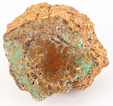 |
Green Chromium Petrified 5x4 Inch Wood Log. This rare and unusual green color petrified wood log section is from the 200 million year old Woodworthia sp. tree of Goliwe, Zimbabwe. The partial log is 5 inches in diameter and 4 inches thick and has the highly desirable green color on its polished top which occurred when Chromium from the ground water replaced the wood cells of the original tree. This color does not occur with the petrified wood from Arizona. This is a good sized specimen as almost all of the petrified wood from Zimbabwe is small in diameter. Estimate Value $500 - UP
View details and enlarged photo
| Unsold |
Lot 709 |
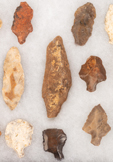 |
20 Aterian Arrows, Spear Points And Scrapers. This lot consists of 20 Aterian artifacts that are between 25,000-80,000 years old and were made by either Neanderthals or early Cro-Magnon humans. They come from an eroded site in the Sahara Desert of Algeria in North Africa. They were made from many different types of rocks such as quartz, flint, chert and jasper and many of them exhibit a polished desert varnish from the thousands of years of being polished by the wind and sand. These original Aterian stone tools range in size from 1.5 inches to 3.5 inches and have a variety of shapes from points that were used for spears to side scrapers and end scrapers with many hafted to attach to wood. This diverse collection has most of the specimens exhibiting the Levallois technique of production which has been traced back to the Neanderthals. The Levallois technique results in tools with a somewhat flat back and a chiseled front. This result was achieved by first striking flakes from a core stone all the way around the edges and then flaking off the center of the core which will preserve the sharp chiseled edges. These interesting and authentic artifacts of early humans are housed in a 12x8 inch Riker Mount for display. Estimate Value $300 - UP
View details and enlarged photo
| Realized
$120 |